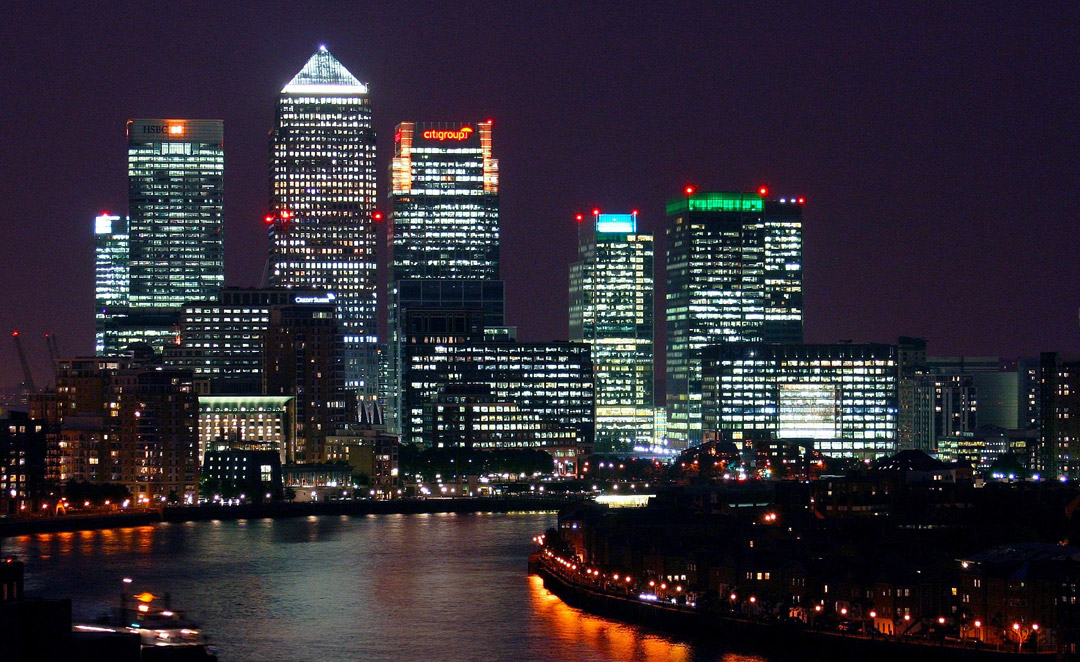Canary Wharf is the largest urban redevelopment project in Europe; from derelict docklands to a dominating financial hub, a lot has changed in the past 20 years. The redevelopment of the area has changed the face of London, offering modern purpose-built premises, as well as renewing the area in which it stands into an attractive area to work, play and live.
Back in the days of the British Empire, The London Docklands were the world’s largest port. They served as one of the country’s biggest ports and helped build the country we know today. Altogether there were 11 docks and in total, and they employed tens of thousands of people. The trade, in which the docks brought made the UK one of the wealthiest and most powerful countries in the world. During the World War II, The Luftwaffe made The Docklands their main target. By bombing the docks, they hoped to paralyse the UK trade and economy, so they dropped bombs on the docks, warehouses, wharves and railway lines. In total 25,000 bombs fell on The Docklands. Many of the bombs were strapped to oil drums to maximise the destruction and the result was a firestorm in the docks that blazed for a whole week. Despite all the damage from the war, in the 1950s the docklands bounced back and were restored. The docks eventually ceased shipping in 1969 because of their small size, difficult labour relations, poor management, and powerful competition from major ports in continental Europe who had much deeper water. They were then boarded off and left to deteriorate. The closing of The London Docklands meant that almost 83,000 jobs were lost which caused the surrounding boroughs to spike in unemployment.
The development of Canary Wharf has in no doubt brought employment back to the area and the number of workers based there is booming, with the number of workers rising from 27,000 to over 100,000 in the space of 10 years, according to figures released by the Office for National Statistics in 2013 and It forecasts that the number of workers will double to 200,000 over the next couple of decades. Chief executive of Canary Wharf Group, Sir George Lacobesu, said that Canary Wharf is working hard to open up job opportunities for the local people. By employing local people in the surrounding areas, it helps replace the jobs that the docks once provided. The outcome of this will mean that there are fewer problems which can be linked with unemployment such as the crime rate, or depression.
As Canary Wharf is relatively new compared to the rest of London, this meant that efficient urban space planning could be done. Canary Wharf was built focusing on helping to create a sustainable future and to halt environmental degradation. One way in which its urban design has created a suitable living environment is by promoting biodiversity. According to The Canary Wharf Group, they have created a suitable living environment for native and threatened species of plants and animals. They have made biodiversity the focus of every building and development they create, such as by having living roofs, green spaces and fish walls. The fish walls are a rather interesting part – they help to rebuild the habitat of the fish that live in the docks. This will ensure that they will have a healthy population in the future. By including areas such as the roof top garden it allows people to feel more connected to nature, despite the fact they are in the middle of the city. This can boost mood and wellbeing, as well as allowing wildlife to thrive. The schemes will also improve air quality in the development.
Canary Wharf Group also has a big community presence. They work in partnership with the local community and help boost the local economy which then local businesses can take advantage of. According to Elba30, “There are still reports that very local residents believe that Canary Wharf is not for them. We need to make jobs more accessible to all local residents.” To combat this, Canary Wharf has been getting involved with some innovative programs. Some of the schemes include “Ready for Work” and the “Women’s Project”. These schemes provide work experience for people who have been homeless or out of work for a long time. The experience aims to build their confidence and get them back into work. This is great for the community as Tower Hamlets is one of the most deprived boroughs of London, so by helping more people get into work, it will encourage their local economy to grow.
As Canary Wharf continues to grow and develop, it’s a completely unrecognisable place to the Docklands which once stood there. The urban redevelopment has demonstrated how London managed to repurpose an area which was wasting away and build it into a strong industry, creating many jobs and preparing the area for the future. The Isle of Dogs has bounced back become a great place to live and work in London.

Recent Comments